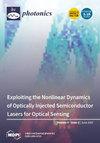Multi-Array Visible-Light Optical Generalized Spatial Multiplexing–Multiple Input Multiple-Output System with Pearson Coefficient-Based Antenna Selection
IF 1.9
4区 物理与天体物理
Q2 OPTICS
引用次数: 0
Abstract
To address the limitations of poor environmental adaptability, unsatisfactory bit-error performance, and high complexity of conventional antenna selection algorithms applied to a multi-array visible-light optical generalized spatial multiplexing–multiple-input multiple-output (OGSMP-MIMO) system, an OGSMP-MIMO system based on Pearson coefficient antenna selection is proposed. The algorithm adopts the correlation of Pearson coefficients among photoelectric detector (PD) terminals at different positions and active transmit antennas to select the optimal antenna combination without relying on the accuracy of channel estimation, for realizing the multiplexing of the time and space domains, and to improve the bit-error performance. Finally, experiments were conducted to verify the feasibility of the antenna selection algorithm, based on the Pearson coefficients. The results indicated that when the bit-error rate reached 10−6, using the antenna selection algorithm based on the Pearson coefficient, the signal-to-noise ratio was improved by 2.7 dB and 3.7 dB when compared with the norm-based antenna and random selection algorithms, respectively. In addition, increasing the number of active transmitting antennas can improve the transmission rate; however, the bit-error performance will be compromised. In the same modulation mode, increasing the number of transmitting antennas will reduce the bit-error performance.基于皮尔逊系数天线选择的多阵列可见光光学广义空间复用-多输入多输出系统
针对传统天线选择算法在多阵列可见光广义空间复用-多输入多输出(OGSMP-MIMO)系统中存在的环境适应性差、误码性能不理想、复杂度高等问题,提出了一种基于皮尔逊系数天线选择的 OGSMP-MIMO 系统。该算法利用不同位置的光电探测器(PD)终端与有源发射天线之间的皮尔逊系数相关性,在不依赖信道估计精度的情况下选择最优天线组合,实现时域和空域的复用,提高误码率性能。最后,实验验证了基于皮尔逊系数的天线选择算法的可行性。结果表明,当误码率达到 10-6 时,使用基于皮尔逊系数的天线选择算法,信噪比与基于规范的天线选择算法和随机选择算法相比,分别提高了 2.7 dB 和 3.7 dB。此外,增加有效发射天线的数量可以提高传输速率,但会影响误码性能。在相同的调制模式下,增加发射天线的数量会降低误码率。
本文章由计算机程序翻译,如有差异,请以英文原文为准。
求助全文
约1分钟内获得全文
求助全文
来源期刊

Photonics
Physics and Astronomy-Instrumentation
CiteScore
2.60
自引率
20.80%
发文量
817
审稿时长
8 weeks
期刊介绍:
Photonics (ISSN 2304-6732) aims at a fast turn around time for peer-reviewing manuscripts and producing accepted articles. The online-only and open access nature of the journal will allow for a speedy and wide circulation of your research as well as review articles. We aim at establishing Photonics as a leading venue for publishing high impact fundamental research but also applications of optics and photonics. The journal particularly welcomes both theoretical (simulation) and experimental research. Our aim is to encourage scientists to publish their experimental and theoretical results in as much detail as possible. There is no restriction on the length of the papers. The full experimental details must be provided so that the results can be reproduced. Electronic files and software regarding the full details of the calculation and experimental procedure, if unable to be published in a normal way, can be deposited as supplementary material.
 求助内容:
求助内容: 应助结果提醒方式:
应助结果提醒方式:


